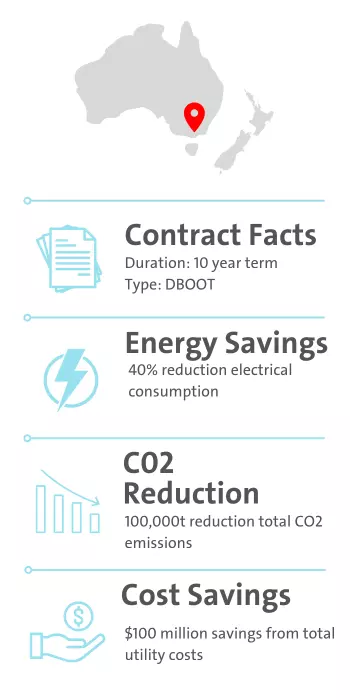CREATING A CARBON-NEUTRAL CAMPUS
| The Challenge
At just 21 years old, the University of the Sunshine Coast (USC) is Australia’s youngest university. Despite this, USC is leading the way in adopting innovation through all aspects of higher education. USC committed to achieving the ambitious target of carbon neutrality by 2025, and to make such a substantial impact requires major capital investment. Due to tertiary sector budget constraints the university looked to a strategic alliance to reach net zero.
Veolia presented a Market-led Proposal (MLP) to partner with USC to achieve their goals. Outlined in the MLP were:
- Highly innovative, step-change style impacts for energy and water utility reliance and carbon reduction that did not rely on purchasing carbon credits;
- A commitment to zero client capital outlay; and
- A transparent, open-book partnership model which detailed value for money.
The project was a Design, Build, Own, Operate, Transfer (DBOOT) agreement with open-book build costs and an agreed-upon internal rate of return (IRR). This flexibility allowed Veolia to develop a truly unique design to encapsulate USC’s vision.
| Veolia’s Solution
Innovation is embedded into the cultures of both USC and Veolia. The two associates’ values aligned and the partnership progressed through an open and trusted relationship. Veolia’s proposal was based on a shared vision for the continual sustainable development of the Sippy Downs Campus by providing a highly technical and cost-efficient energy solution.
This innovative and integrated approach positions USC at the forefront of energy reduction and management, forging leadership in sustainability across the higher education sector and beyond.
Veolia committed to building the sophisticated plant at no cost to the university, and to operate and maintain the infrastructure for 10 years. After this time, ownership of the infrastructure will transfer to USC.
Project overview:
- Installation of 2.1MW solar photovoltaic (PV) network on roofs across the campus and car park shade structures. While this network will largely be dedicated to operating the HVAC plant, the excess energy will be distributed across the campus;
- Construction of a 4.5ML thermal energy storage (TES) tank (chilled water), effectively acting as an 8MW-equivalent electrical battery for the campus’s HVAC system;
- Removal of old, energy-intensive chillers and refrigerant gases and replacing them with environmentally-friendly HFO gases, which removes risk of significant carbon emissions leakage. The New Trane HFO Ceramic Bearing Chillers are a 1st in Australia;
- Introduction of a 8.2MW cooling plant and and ultrafiltration lake water recovery plant which saves 802 megalitres of potable water annually; and
- Advanced Trane Tracer control system.

Like this solution?
Start implementing proven tactics today!
Explore our range of services to discover how you can achieve your operational and sustainability goals.
| The Benefits
The progressive partnership between USC and Veolia is highly innovative and undoubtedly beneficial.
Australia-first innovation
USC’s thermal battery is the first of its kind to be powered by renewables, maximising its energy efficiency.
Significant reduction in grid energy reliance
The campus saw a 40% reduction in energy sourced from the local electrical grid, effectively reducing fossil fuel consumption as a result. It is expected the equivalent of 100,000 tonnes total CO2 emissions will be avoided. Emissions and cost reduction is supported by the inclusion of an advanced building management system (BMS) that allows for seamless transition between solar, mains electricity, and chilled water storage as needed.
Operational cost savings
The expected savings from reduced utility costs is estimated $100 million over the course of the project’s 25-year lifespan.

HOW CAN WE HELP?
Our team of industry experts are here to support you and your business. We work alongside you to propel your sustainability efforts forward and achieve a common goal of Ecological Transformation.


